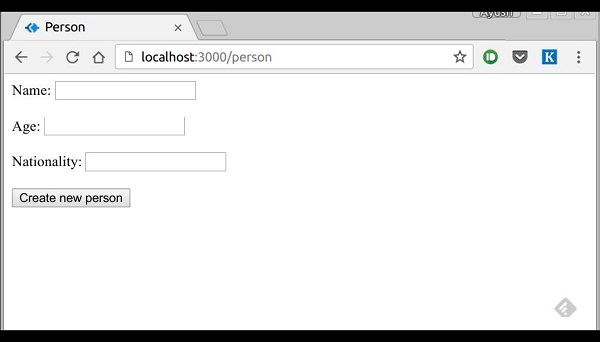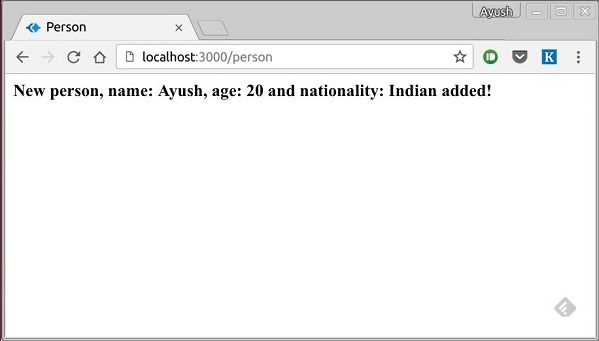We are receiving the requests, but are not storing them anywhere. We
need a Database to store the data. We'll use a famous NoSQL database
called MongoDB. To install and read about Mongo, head over to this link.
In order to use Mongo with express we need a client API for node. There are multiple options for us, but for this tutorialm we'll stick to mongoose. Mongoose is used for document Modeling in Node for MongoDB. document modeling means that, we will create a Model(much like a class in document oriented programming), and then we will produce documents using this Model(like we create documents of a class in OOP). All our processing will be done on these "documents", then finally, we will write these documents in our database.
To use mongoose, we will require it in our index.js file and then connect to the mongod service running on mongodb://localhost
 We'll now define a post route handler at '/person' which will handle this request:
We'll now define a post route handler at '/person' which will handle this request:
To show the response from this route, we will also need to create a show_message view. Create a new view with the following code:
 We now have an interface to create persons!
We now have an interface to create persons!
In order to use Mongo with express we need a client API for node. There are multiple options for us, but for this tutorialm we'll stick to mongoose. Mongoose is used for document Modeling in Node for MongoDB. document modeling means that, we will create a Model(much like a class in document oriented programming), and then we will produce documents using this Model(like we create documents of a class in OOP). All our processing will be done on these "documents", then finally, we will write these documents in our database.
Setting up mongoose
Now that you have Mongo installed, let us install mongoose, the same way we have been installing our other node packages:npm install --save mongooseBefore we start using mongoose, we have to create a database using the mongo shell. To create a new database, open your terminal and enter "mongo". A Mongo shell will start, enter the following,
use my_dbA new database will be created for you. Whenever you open up the mongo shell, it'll default to "test" db and you'll have to change to your database using the same commmand as above.
To use mongoose, we will require it in our index.js file and then connect to the mongod service running on mongodb://localhost
var mongoose = require('mongoose'); mongoose.connect('mongodb://localhost/my_db');Now our app is connected to our database, lets create a new Model. This model will act as a collection in our database. To create a new Model, use the following code, before defining any routes:
var personSchema = mongoose.Schema({ name: String, age: Number, nationality: String }); var Person = mongoose.model("Person", personSchema);The above code defines the schema for a person and is used to create a mongoose Model Person.
Saving documents
Now we will create a new html form which will get the details of a person and save it to our database. To create the form, create a new view file called person.pug in views directory with the following content:html
head
title Person
body
form(action="/person", method="POST")
div
label(for="name") Name:
input(name="name")
br
div
label(for="age") Age:
input(name="age")
br
div
label(for="nationality") Nationality:
input(name="nationality")
br
button(type="submit") Create new person
Also add a new get route in index.js to render this document: app.get('/person', function(req, res){ res.render('person'); });Go to localhost:3000/person to check if our form is displaying right. Note that this is just the UI, its not working yet. This is how our form looks:
 We'll now define a post route handler at '/person' which will handle this request:
We'll now define a post route handler at '/person' which will handle this request:app.post('/person', function(req, res){ var personInfo = req.body; //Get the parsed information if(!personInfo.name || !personInfo.age || !personInfo.nationality){ res.render('show_message', {message: "Sorry, you provided worng info", type: "error"}); } else{ var newPerson = new Person({ name: personInfo.name, age: personInfo.age, nationality: personInfo.nationality }); newPerson.save(function(err, res){ if(err) res.render('show_message', {message: "Database error", type: "error"}); else res.render('show_message', {message: "New person added", type: "success", person: personInfo}); }); } });In the above code, if we recieve any empty field or do not receive any field, we will send an error response. But if we receive a well formed document, then we create a newPerson document from Person model and save it to our DB using newPerson.save() function. This is defined in mongoose and accepts a callback as argument. This callback has 2 arguments, error and response. This will render show_message view, so we need to create that as well.
To show the response from this route, we will also need to create a show_message view. Create a new view with the following code:
html
head
title Person
body
if(type=="error")
h3(style="color:red") #{message}
else
h3 New person, name: #{person.name}, age: #{person.age} and nationality: #{person.nationality} added!
The response we receive on successfully submitting the form(show_message.pug):  We now have an interface to create persons!
We now have an interface to create persons!Retrieving documents
Mongoose provides a lot of functions for retrieving documents, we will focus on 3 of those. All these functions also take a callback as the last parameter, and just like the save function, their arguments are error and response. The three functions are:- Model.find(conditions, callback)This function finds
all the documents matching the fields in conditions object. Same
operators used in Mongo also work in mongoose. For example,
Person.find(function(err, response){ console.log(response); });This will fetch all the documents from the persons collection.
Person.find({name: "Ayush", age: 20}, function(err, response){ console.log(response); });This will fetch all documents where feild name is "Ayush" and age is 20.
We can also provide projection we need, ie, the fields we need. For example, if we want only the names of people whose nationality is "Indian", we use:
Person.find({nationality: "Indian"}, "name", function(err, response){ console.log(response); }); - Model.findOne(conditions, callback)This functions always fetches a single, most relevent document. It has the same exact arguments as Model.find().
- Model.findById(id, callback)This function takes in the _id(defined by mongo) as the first argument, an optional projection string and a callback to handle the response. For example,
Person.findById("507f1f77bcf86cd799439011", function(err, response){ console.log(response); });
var express = require('express'); var app = express(); var mongoose = require('mongoose'); mongoose.connect('mongodb://localhost/my_db'); var personSchema = mongoose.Schema({ name: String, age: Number, nationality: String }); var Person = mongoose.model("Person", personSchema); app.get('/people', function(req, res){ Person.find(function(err, response){ res.json(response); }); }); app.listen(3000);
Updating Documents
Mongoose provides 3 functions to update documents.-
Model.update(condition, updates, callback)
This function takes a conditions and an updates object as
input and applies the changes to all the documents matching the
conditions in the collection. For example, following code will update
all Person documents to have a nationality "American":
Person.update({age: 25}, {nationality: "American"}, function(err, response){ console.log(response); }); -
Model.findOneAndUpdate(condition, updates, callback)
It does exactly what is says. Finds one document based on the
query and updates that according to the second argument. It also takes a
callback as last argument. The following example
Person.findOneAndUpdate({name: "Ayush"}, {age: 40}, function(err, response){ console.log(response); }); -
Model.findByIdAndUpdate(id, updates, callback)
This function updates a single document identified by its id. For example,
Person.findByIdAndUpdate("507f1f77bcf86cd799439011", {name: "James"}, function(err, response){ console.log(response); });
var express = require('express'); var app = express(); var mongoose = require('mongoose'); mongoose.connect('mongodb://localhost/my_db'); var personSchema = mongoose.Schema({ name: String, age: Number, nationality: String }); var Person = mongoose.model("Person", personSchema); app.put('/people/:id', function(req, res){ Person.findByIdAndUpdate(req.params.id, req.body, function(err, response){ if(err) res.json({message: "Error in updating person with id " + req.params.id}); res.json(response); }); }); app.listen(3000);To test this route, enter the folllowing in your terminal(replace the id with an id from your created people):
curl -X PUT --data "name=James&age=20&nationality=American" http://localhost:3000/people/507f1f77bcf86cd799439011This will update the document associated with the id provided in the route with the above details.
Deleting Documents
We have covered Create, Read and Update, now we'll see how mongoose can be used to Delete documents. We have 3 functions here, exactly like update.-
Model.remove(condition, [callback])
This function takes a condition object as input and removes
all documents matching the conditions. For example, if we need to remove
all people aged 20,
Person.remove({age:20}); -
Model.findOneAndRemove(condition, [callback])
This functions removes a single, most relevent document according to conditions object. For example,
Person.findOneAndRemove({name: "Ayush"}); -
Model.findByIdAndRemove(id, [callback])
This function removes a single document identified by its id. For example,
Person.findByIdAndRemove("507f1f77bcf86cd799439011");
var express = require('express'); var app = express(); var mongoose = require('mongoose'); mongoose.connect('mongodb://localhost/my_db'); var personSchema = mongoose.Schema({ name: String, age: Number, nationality: String }); var Person = mongoose.model("Person", personSchema); app.delete('/people/:id', function(req, res){ Person.findByIdAndRemove(req.params.id, function(err, response){ if(err) res.json({message: "Error in deleting record id " + req.params.id}); else res.json({message: "Person with id " + req.params.id + " removed."}); }); }); app.listen(3000);To test this out, use the following curl command:
curl -X DELETE http://localhost:3000/people/507f1f77bcf86cd799439011This will remove the person with given id producing the following message:
{message: "Person with id 507f1f77bcf86cd799439011 removed."}
This wraps up how we can create simple CRUD applications using
MongoDB, mongoose and Express. To explore mongoose further, read the API docs.
No comments:
Post a Comment